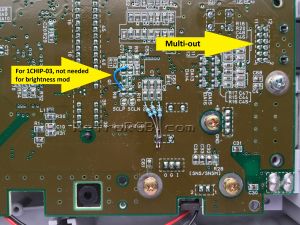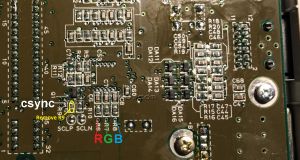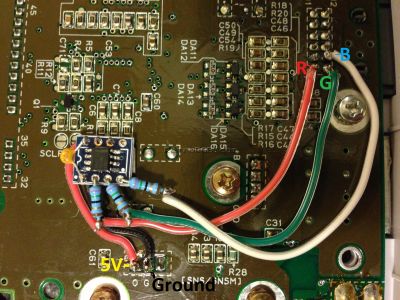SNES:1CHIP Mods
Brightness Fix
All 1CHIP consoles output a signal that's too bright. This can result in an image that's slightly washed out, or shows signs of "ringing". In fact, it's possible that this is a big part of the reason some people think SNES Mini's look better then 1CHIP's. Luckily, the fix is _extremely_ easy!
- Disassemble the 1CHIP console and flip the board over.
- Locate the "R6", "R7" and "R8" RGB via holes
- Solder three 750 Ohm resistors to the holes and then solder all of them to the ground point shown in the picture.
- Trim any of the resistors that are sticking out the other end.
1CHIP-03 CSYNC Fix
There are three revisions of the 1CHIP motherboard: SNS-CPU-1CHIP-01, SNS-CPU-1CHIP-02 and SNS-CPU-1CHIP-03. The "03" revision does not have csync run to the multi-out. You can use these consoles without a modification, simply by using an RGB SCART cable that gets sync from luma. You can restore csync on these consoles by using a simple jumper wire, however that doesn't seem to be the best solution, as it's missing circuitry found in the other 1CHIP revisions: http://www.retrorgb.com/snescsync.html#1chip-03
If you have a 1CHIP-03, you'll want to consider using a sync-on-luma cable, restoring the entire circuit on the motherboard, or using an RGB bypass board that includes the full csync circuit.
1CHIP RGB Bypass
Even though the 1CHIP consoles already output high quality RGB, you still might want to bypass the onboard amp and use a different one.
You can use a Voultar's SNES 1CHIP/Mini RGB Bypass Kit or you can create a DIY RGB Amp board.
- Remove the motherboard and locate the multi-out pins on the bottom of the board.
- Right near the multi-out, you'll find resistors labeled R15, R16 and R17 and a capacitor labeled C46 - These connect RGBs to the multi-out.
- De-solder these components to remove the RGB connection to the multi-out. If you have a SNS-CPU-1CHIP-03, C46 will already be removed.
- Now solder wires to the RGBs vias (holes) that are near the cartridge port.
- R6, R7, R8 and R9 are RGBs, respectively.
- After adding the RGB wires, remove the "R9" resistor shown in the picture. If you have a 1CHIP-03, the resistor will already be missing.
Since all 1CHIP's already have S-Video run to the board, the S-Video pads will not be used. The THS7374 low-pass filter can manipulated by shorting the LPF jumper.



